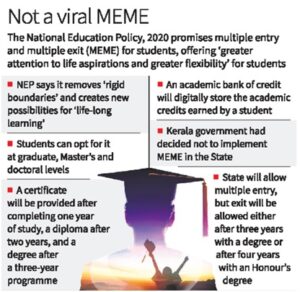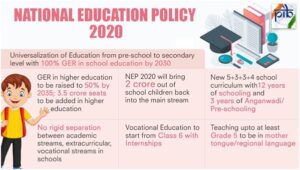Multiple entry, exit may not suit India
Relevance
- GS 2: Issues Relating to Development and Management of Social Sector/Services relating to Health, Education, Human Resources.
- Tags: #NEP #MEME #TheHindu #UPSC #CurrentAffairs #GS2.
Why in the News?
The Parliamentary Standing Committee on Education, led by MP Vivek Thakur, has raised concerns about the feasibility of Multiple Entry and Multiple Exit (MEME) options in India’s National Education Policy (NEP).
Multiple Entry and Multiple Exit (MEME)
- The National Education Policy (NEP) is a comprehensive framework that shapes the education system of a country.
- Multiple entry and exit points in education refer to a flexible education system that allows learners to join and leave the formal education system at various stages without strict adherence to traditional grade-level structures.
Features of MEME in NEP
- Creative Combinations of Disciplines: Flexible curricular structures enable creative combinations of disciplines for study, offering multiple entry and exit points.
- Academic Bank of Credits (ABC): The NEP 2020 proposes the establishment of an Academic Bank of Credits to facilitate seamless student mobility between or within HEIs through credit recognition, accumulation, transfer, and redemption.
- Synchronization of General and Vocational Education: The NEP 2020 aims to synchronize general education with vocational and skill education, creating pathways for students to develop both academic and practical skills.
Academic Bank of Credits (ABC)
- Purpose: The ABC is designed to promote flexibility in the curriculum, interdisciplinary/multidisciplinary academic mobility, and multiple entry and exit options for students across HEIs.
- Integration of Disciplines: ABC enables the integration of multiple disciplines of higher learning, leading to increased creativity, innovation, and higher-order thinking skills.
- Credit Accumulation and Transfer: Students can accumulate credits in their Academic Bank Account from courses taken in various eligible Higher Education Institutes(HEIs) and redeem these credits to earn certificates, diplomas, or degrees.
Admission Paths for Undergraduate Programs
- Entry Criteria: Students who have completed Grade 12 School Leaving Certificate are eligible for admission to undergraduate programs.
- Duration: The undergraduate degree can be three or four years, with multiple entry and exit options and appropriate certifications.
- Example: Options include certificates after one year, diplomas after two years, and Bachelor’s degrees after three years. The preferred option is the four-year multidisciplinary program.
- Research Component: The four-year program may include research, leading to a degree with research for academically capable students.
- Lateral Entry: HEIs may allow lateral entry to the second, third, or fourth year of a bachelor’s program based on prior educational achievements.
- Credit Validity: Credits earned are valid for a maximum period of seven years or as specified by the ABC.
Master’s Program
- Admission Paths: Master’s programs offer different entry and exit options, including a two-year program with a research-focused second year, a one-year program for four-year bachelor’s degree holders with research, and integrated five-year programs.
Skill-Based Exits
- Skill Certifications: Students can exit with recognized skill certifications.
- Internship Opportunities: Encourages internships and practical experiences.
Positive Impacts of MEME
Flexibility in Education Pathways
- Adaptive Learning: MEME allows students to choose diverse education pathways based on their interests and abilities.
- Reduced Dropout Rates: It minimizes dropout rates as students can exit at various stages with recognized qualifications.
- Skill Development: Encourages skill-based learning, leading to a more skilled workforce.
- Flexibility and Inclusivity: MEME promotes inclusivity by accommodating students with diverse needs, allowing them to start or continue their education at their own pace.
- Addressing Learning Disabilities: It enables personalized learning paths for students with learning disabilities, ensuring they receive appropriate support.
- Career Progression: MEME offers pathways for career progression by recognizing partial completion of education.
- Enhanced Employability: Allows individuals to enter the workforce earlier with recognized qualifications, enhancing employability.
Inclusive Education
- Equity: MEME promotes equity as it accommodates learners with different learning abilities.
- Lifelong Learning: Adults can re-enter the education system easily to acquire new skills or credentials.
Industry Relevance
- Alignment with Market Needs: Graduates can exit and enter the workforce with relevant skills and knowledge.
- Entrepreneurship: Encourages entrepreneurship by enabling individuals to start their ventures at various points.
Negative Impacts of MEME
Quality Concerns
- Dilution of Standards: Frequent exits may lead to a perception of diluted quality in education.
- Inconsistency: Maintaining quality across diverse entry and exit points can be challenging.
Geographical Distribution Challenges
- The uneven distribution of educational institutions across different regions of India is discussed as a major hurdle in effectively managing the MEME system, particularly in rural areas.
Bureaucratic Challenges
- Administrative Complexities: Implementing MEME requires significant administrative efforts.
- Resource Allocation: Allocating resources to support diverse educational pathways can strain budgets.
Societal Stigma
- Social Pressure: Society might stigmatize early exits, leading to social and psychological pressures on students.
- Employer Perceptions: Some employers may prefer traditional degree holders over MEME graduates.
Way Ahead for MEME in NEP
- Quality Assurance: Develop clear standards and assessment criteria for various exit points. Equip educators with the skills to handle diverse learning paths.
- Monitoring and Evaluation: Employ data-driven approaches to monitor student progress and identify bottlenecks.
- Feedback Mechanisms: Create feedback channels for students, teachers, and employers.
- Awareness Campaigns: Conduct campaigns to change societal perceptions regarding MEME.
- Employer Engagement: Engage with employers to value MEME graduates.
- Pilot Programs: Start with pilot programs to test the feasibility and effectiveness of MEME.
- Stakeholder Engagement: Involve all stakeholders, including educators, parents, and students, in shaping and implementing MEME.
- Resource Allocation: Allocate sufficient resources for infrastructure, teacher training, and technology integration.
- International Collaboration: Collaborate with countries with successful MEME systems for knowledge sharing and best practices.
- Policy Advocacy: Advocate for policy changes and reforms to support MEME at the national level.
Global Best Practices
United States
- Recognizes credits through the Credit Hour System, allowing students to exit and re-enter higher education with ease.
- Employers value certifications and skills, reducing the stigma associated with non-traditional pathways.
European Union
- Implements the European Credit Transfer and Accumulation System (ECTS) for seamless credit transfer.
- Offers vocational education alongside traditional degrees, emphasizing skill development.
Implementing MEME in the NEP requires a comprehensive and well-planned approach, drawing inspiration from global best practices while addressing potential challenges. Continuous evaluation and adaptation will be key to its success in transforming the Indian education system.
Source: The Hindu
Mains Question
Discuss the significance of a multiple entry and exit system in higher education as outlined in the National Education Policy (NEP) 2020. Explain how this system can help reduce dropout rates and improve Gross Enrolment Ratio?





